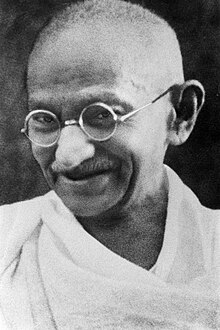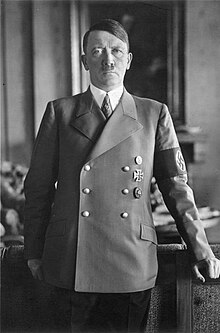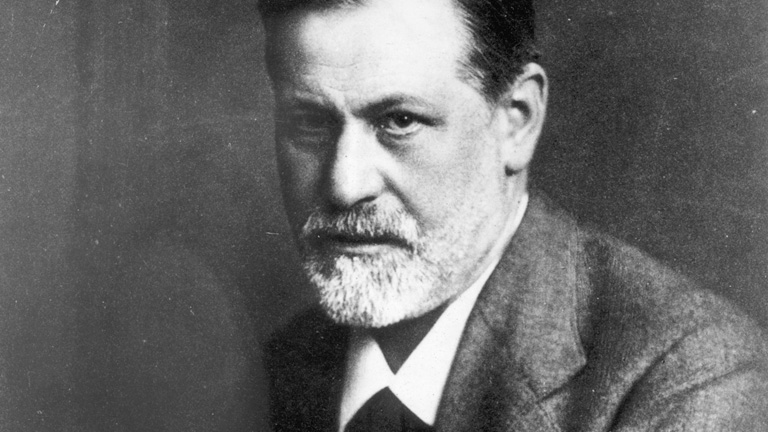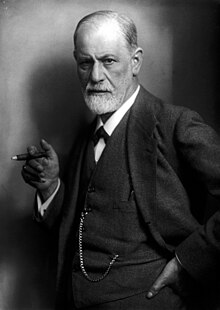Vallabhbhai Jhaverbhai Patel ( 31 October 1875 – 15 December 1950) was an Indian barrister and statesman, one of the leaders of the Indian National Congress and one of the founding fathers of the Republic of India. He was a social leader who played a leading role in the country's struggle for independence and guided its integration into a united, independent nation. In India and elsewhere, he was often addressed as Sardar,[1] which means Chief in Hindi, Urdu and Persian.
He was raised in the countryside of Gujarat.[2] Patel was employed in successful practice as a lawyer. He subsequently organised peasants from Kheda, Borsad, and Bardoli in Gujarat in non-violent civil disobedience against oppressive policies imposed by the British Raj; in this role, he became one of the most influential leaders in Gujarat. He rose to the leadership of the Indian National Congress, in which capacity he would organise the party for the elections held in 1934 and 1937, as well as continue to promote the Quit India Movement.
As the first Home Minister and Deputy Prime Minister of India, Patel organised relief for refugees fleeing from Punjab and Delhi and led efforts to restore peace across the nation. Patel took charge of the task to forge a united India by integrating into the newly independent nation those British colonial provinces "allocated" to India. Besides those provinces under direct British rule, approximately 565 self-governing princely states had been released from British suzerainty by the Indian Independence Act 1947. Through both frank diplomacy as well an option to deploy military force, Patel would persuade almost every princely state to accede to India. Patel's commitment to national integration in the newly independent country was total and uncompromising, earning him the sobriquet "Iron Man of India"[citation needed]. He is also affectionately remembered as the "Patron saint of India's civil servants" for having established the modern all-India services system.
An annual commemoration of Patel, known as the Rashtriya Ekta Diwas (National Unity Day), was introduced by the Government of India in 2014 and is to be held annually on his birthday, 31 October.
Early life[edit]
Sardar Vallabhai Patel painting as deputy prime minister in 1948 issue of Chandamama magazine.
The date of birth of Vallabhbhai Patel was never officially recorded – Patel entered 31 October as his date of birth on his matriculation examination papers. He was born in Leva Patel caste of Gujarat.[3]
Patel travelled to attend schools in Nadiad, Petlad and Borsad, living self-sufficiently with other boys. He reputedly cultivated a stoic character. A popular anecdote recounts how he lanced his own painful boil without hesitation, even as the barber supposed to do it trembled.[4] Patel passed his matriculation at the relatively late age of 22; at this point, he was generally regarded by his elders as an unambitious man destined for a commonplace job. Patel himself, though, harboured a plan to study to become a lawyer, work and save funds, travel to England and study to become a barrister.[5] Patel spent years away from his family, studying on his own with books borrowed from other lawyers, passing his examinations within two years. Fetching his wife Jhaverba from his parents' home, Patel set up his household in Godhra and was called to the bar. During the many years it took him to save money, Patel – now an advocate – earned a reputation as a fierce and skilled lawyer. The couple had a daughter, Maniben, in 1904, and a son, Dahyabhai, in 1906. Patel also cared for a friend suffering from Bubonic plague when it swept across Gujarat. When Patel himself came down with the disease, he immediately sent his family to safety, left his home and moved into an isolated house in Nadiad (by other accounts, Patel spent this time in a dilapidated temple); there, he recovered slowly.[6]
Patel practised law in Godhra, Borsad and Anand while taking on the financial burdens of his homestead in Karamsad. Patel was the first chairman and founder of the E.M.H.S. "Edward Memorial High School" Borsad, presently known as Jhaverbhai Dajibhai Patel High School. When he had saved enough for England and applied for a pass and a ticket, they arrived in the name of "V. J. Patel," at his elder brother Vithalbhai's home, who bore the same initials. Having once nurtured a similar hope to study in England, Vithalbhai remonstrated to his younger brother that it would be disreputable for an older brother to follow his younger brother. In keeping with concerns for his family's honour, Patel allowed Vithalbhai to go in his place.[7]
In 1909, Patel's wife Jhaverba was hospitalised in Bombay (now Mumbai) to undergo a major surgical operation for cancer. Her health suddenly worsened and, despite successful emergency surgery, she died in the hospital. Patel was given a note informing him of his wife's demise as he was cross-examining a witness in court. According to witnesses in the court, Patel read the note, pocketed it and continued to intensely cross-examine the witness and won the case. He broke the news to others only after the proceedings had ended.[8] Patel decided against marrying again. He raised his children with the help of his family and sent them to English-medium schools in Mumbai. At the age of 36, he journeyed to England and enrolled at the Middle Temple Inn in London. Finishing a 36-month course in 30 months, Patel topped his class despite having no previous college background"[citation needed].
Returning to India, Patel settled in the city of Ahmedabad and became one of the city's most successful barristers. Wearing European-style clothes and urbane mannerisms, he became a skilled bridge player. Patel nurtured ambitions to expand his practice and accumulate great wealth and to provide his children with a modern education. He had made a pact with his brother Vithalbhai to support his entry into politics in the Bombay Presidency, while Patel remained in Ahmedabad to provide for the family.[9]
He was a vegetarian.[10]
He was raised in the countryside of Gujarat.[2] Patel was employed in successful practice as a lawyer. He subsequently organised peasants from Kheda, Borsad, and Bardoli in Gujarat in non-violent civil disobedience against oppressive policies imposed by the British Raj; in this role, he became one of the most influential leaders in Gujarat. He rose to the leadership of the Indian National Congress, in which capacity he would organise the party for the elections held in 1934 and 1937, as well as continue to promote the Quit India Movement.
As the first Home Minister and Deputy Prime Minister of India, Patel organised relief for refugees fleeing from Punjab and Delhi and led efforts to restore peace across the nation. Patel took charge of the task to forge a united India by integrating into the newly independent nation those British colonial provinces "allocated" to India. Besides those provinces under direct British rule, approximately 565 self-governing princely states had been released from British suzerainty by the Indian Independence Act 1947. Through both frank diplomacy as well an option to deploy military force, Patel would persuade almost every princely state to accede to India. Patel's commitment to national integration in the newly independent country was total and uncompromising, earning him the sobriquet "Iron Man of India"[citation needed]. He is also affectionately remembered as the "Patron saint of India's civil servants" for having established the modern all-India services system.
An annual commemoration of Patel, known as the Rashtriya Ekta Diwas (National Unity Day), was introduced by the Government of India in 2014 and is to be held annually on his birthday, 31 October.
Early life[edit]
Sardar Vallabhai Patel painting as deputy prime minister in 1948 issue of Chandamama magazine.
The date of birth of Vallabhbhai Patel was never officially recorded – Patel entered 31 October as his date of birth on his matriculation examination papers. He was born in Leva Patel caste of Gujarat.[3]
Patel travelled to attend schools in Nadiad, Petlad and Borsad, living self-sufficiently with other boys. He reputedly cultivated a stoic character. A popular anecdote recounts how he lanced his own painful boil without hesitation, even as the barber supposed to do it trembled.[4] Patel passed his matriculation at the relatively late age of 22; at this point, he was generally regarded by his elders as an unambitious man destined for a commonplace job. Patel himself, though, harboured a plan to study to become a lawyer, work and save funds, travel to England and study to become a barrister.[5] Patel spent years away from his family, studying on his own with books borrowed from other lawyers, passing his examinations within two years. Fetching his wife Jhaverba from his parents' home, Patel set up his household in Godhra and was called to the bar. During the many years it took him to save money, Patel – now an advocate – earned a reputation as a fierce and skilled lawyer. The couple had a daughter, Maniben, in 1904, and a son, Dahyabhai, in 1906. Patel also cared for a friend suffering from Bubonic plague when it swept across Gujarat. When Patel himself came down with the disease, he immediately sent his family to safety, left his home and moved into an isolated house in Nadiad (by other accounts, Patel spent this time in a dilapidated temple); there, he recovered slowly.[6]
| Vallabhbhai Patel | |
|---|---|
 | |
| 1st Deputy Prime Minister of India | |
| In office 15 August 1947 – 15 December 1950 | |
| Prime Minister | Jawaharlal Nehru |
| Preceded by | Position established |
| Succeeded by | Morarji Desai |
| Minister of Home Affairs | |
| In office 15 August 1948 – 15 December 1950 | |
| Prime Minister | Jawaharlal Nehru |
| Preceded by | Position established |
| Succeeded by | Chakravarti Rajagopalachari |
| Personal details | |
| Born | Vallabhai Jhaverbhai Patel 31 October 1875 Nadiad, Gujarat, Bombay Presidency, British India |
| Died | 15 December 1950 (aged 75) Bombay, Bombay State, India |
| Nationality | Indian |
| Political party | Indian National Congress |
| Spouse(s) | Jhaverba |
| Children | Maniben Patel, Dahyabhai Patel |
| Alma mater | Inns of Court |
| Profession | Lawyer Political activist |
| Religion | Hinduism |
| Awards | Bharat Ratna |
Patel practised law in Godhra, Borsad and Anand while taking on the financial burdens of his homestead in Karamsad. Patel was the first chairman and founder of the E.M.H.S. "Edward Memorial High School" Borsad, presently known as Jhaverbhai Dajibhai Patel High School. When he had saved enough for England and applied for a pass and a ticket, they arrived in the name of "V. J. Patel," at his elder brother Vithalbhai's home, who bore the same initials. Having once nurtured a similar hope to study in England, Vithalbhai remonstrated to his younger brother that it would be disreputable for an older brother to follow his younger brother. In keeping with concerns for his family's honour, Patel allowed Vithalbhai to go in his place.[7]
In 1909, Patel's wife Jhaverba was hospitalised in Bombay (now Mumbai) to undergo a major surgical operation for cancer. Her health suddenly worsened and, despite successful emergency surgery, she died in the hospital. Patel was given a note informing him of his wife's demise as he was cross-examining a witness in court. According to witnesses in the court, Patel read the note, pocketed it and continued to intensely cross-examine the witness and won the case. He broke the news to others only after the proceedings had ended.[8] Patel decided against marrying again. He raised his children with the help of his family and sent them to English-medium schools in Mumbai. At the age of 36, he journeyed to England and enrolled at the Middle Temple Inn in London. Finishing a 36-month course in 30 months, Patel topped his class despite having no previous college background"[citation needed].
Returning to India, Patel settled in the city of Ahmedabad and became one of the city's most successful barristers. Wearing European-style clothes and urbane mannerisms, he became a skilled bridge player. Patel nurtured ambitions to expand his practice and accumulate great wealth and to provide his children with a modern education. He had made a pact with his brother Vithalbhai to support his entry into politics in the Bombay Presidency, while Patel remained in Ahmedabad to provide for the family.[9]
He was a vegetarian.[10]
.jpg)










